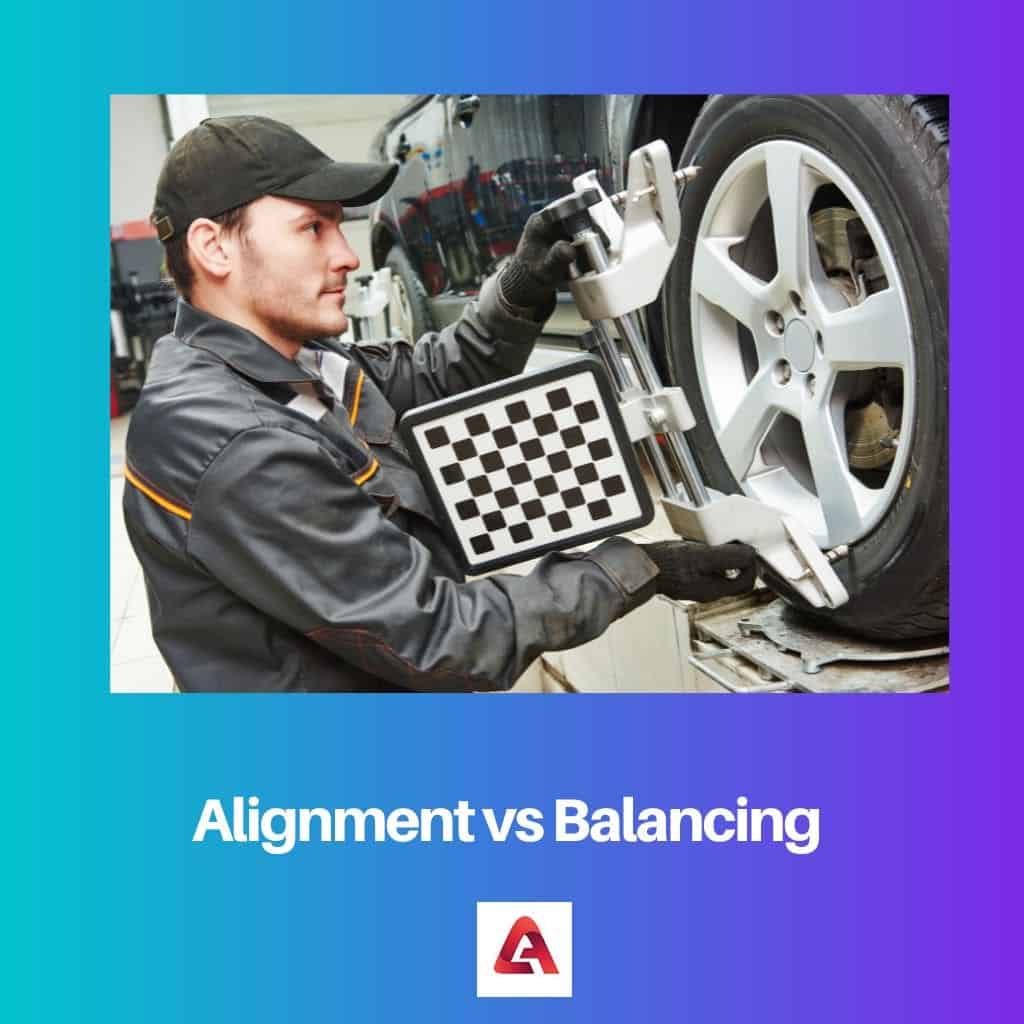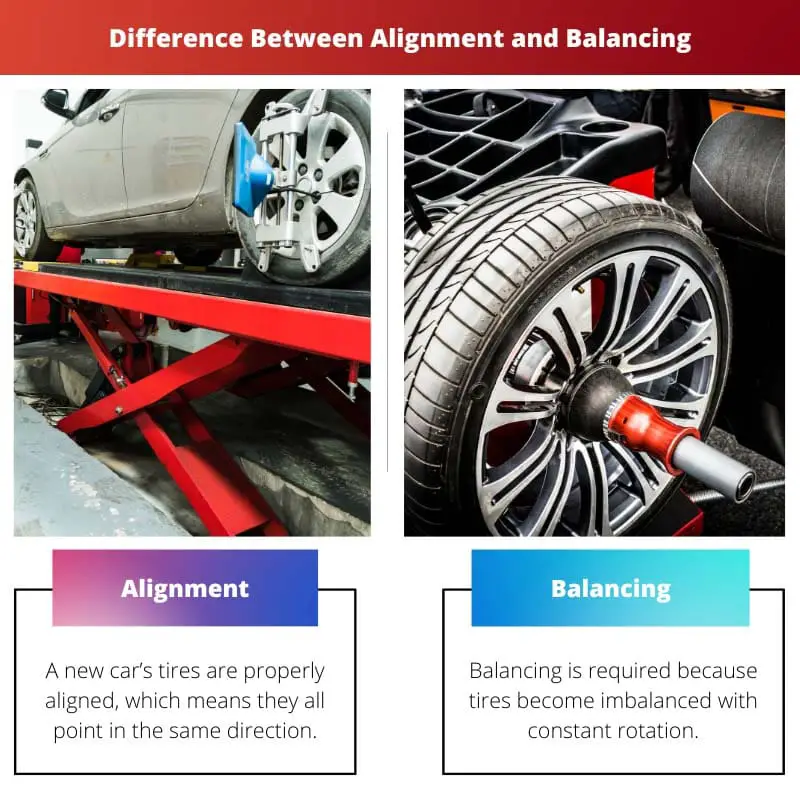Key Takeaways
- Alignment adjusts a vehicle’s suspension to ensure proper positioning of the wheels while balancing distributes weight evenly across the tires to minimize vibrations.
- Proper alignment improves tire longevity, fuel efficiency, and handling, whereas accurate balancing reduces tire wear and enhances ride comfort.
- Technicians perform alignment using computerized equipment to adjust suspension angles, while they use balancing machines to identify and correct weight imbalances on tires.
Alignment vs Balancing

Wheel alignment is the process of adjusting the angle of the wheels so that your car steers in the right direction while driving.
Not to mention that proper wheel alignment enhances the life of the tires and keeps them from wearing out prematurely.
Camber, toe, and caster alignment are the three ways of adjusting wheel alignment.
Wheel balancing is keeping the tire and rim perfectly balanced for even mass distribution.
At a particular speed on the highway, the driver will feel vibrations on the steering and seats if there is an imbalance inside the wheels.
Tire balancing corrects an uneven weight distribution in the wheels. Imbalanced wheels can cause vibration, excessive tire wear, suspension damage, and other issues.
Comparison Table
| Parameters of Comparison | Alignment | Balancing |
|---|---|---|
| Definition | It achieves a smoother ride, reduces tire wear, the decreases the strain on the drivetrain. | It corrects the weight imbalance and wheel assemblies. |
| Benefits | It helps obtain a smoother ride and increases the tire’s life. | Uneven tire wear, and vibrations in your seat, floorboard, or steering wheel. |
| It helps obtain a smoother ride and increases the tire’s life. | Rapid tire wear, squealing tires. | Potholes, mismatched tires, heavy loads, aggressive driving, everyday wear, and tear. |
| Causes of Problems | Potholes, mismatched tires, heavy loads, aggressive driving, everyday wear and tear. | Sudden impacts, worn-out suspension parts, normal tire wear, and imperfections. |
| Cost | More expensive | Cheaper |
What is Alignment?
A new car’s tires are correctly aligned, which means they all point in the same direction. This ensures that neither tire pushes outward nor pulls inward, producing problems with the car.
When the wheels are precisely aligned, the tires provide higher mileage.
Wheel alignment refers to adjusting the geometry of the wheels, which can become compromised owing to lousy suspension.
This can occur when your automobile hits a large pothole, is involved in an accident, or when you install a new set of tires in your vehicle.
Wheel alignment, also known as tracking, ensures that the wheels are perpendicular to the road and parallel.
You can have a two wheel alignment (front axle) or a four wheel alignment (front and rear axles).
During the assessment, the technician will inspect the camber, toe, and caster.
Camber refers to the angle of the steering pivot as seen from the side of the vehicle; toe refers to the direction the tires point in respect to each other, and caster refers to the angle of the steering pivot as seen from the side of the vehicle.
Alignment prevents your vehicle from drifting to the right or left. It can also improve your vehicle’s handling and eliminate strange on-road vibrations.

What is Balancing?
Balancing is required because tires become imbalanced with constant rotation. Out-of-balance tires produce vehicle vibration, which raises the likelihood of a collision at more incredible speeds.
Tire balancing is thus required after every 12-15 thousand miles of running. Balancing also guarantees that your tires last longer because balancing reduces tire wear significantly.
When a wheel is installed on a vehicle, it should be precisely balanced. Wheels lost balance with time, causing the weight distribution and contact patch (the tire section in contact with the road) to change.
Wheel balancing is used to rebalance the weight and guarantee that the tire rotates uniformly. Small balancing weights are added to the rim to compensate for weight irregularities.
Unevenness in a tire or rim can throw the wheel off balance. Tires and wheels cannot rotate ideally without proper wheel balance, resulting in uneven tire wear.
If your wheels are correctly balanced, you may expect a safer driving experience with fewer vibrations throughout the vehicle.
During a tire balance procedure, your tires and wheels are put onto a tire balancing machine.
The machine spins the tire and wheel assembly to measure the imbalance, allowing a technician to accurately insert the exact tire weights for a fully balanced wheel and tire combination.
Main Differences Between Alignment and Balancing
- An alignment corrects the angle of the tire, while balancing corrects the weight imbalance.
- Alignment helps get a smoother ride and increases the tire’s life while balancing achieves a smoother ride and reduces tire wear. This decreases the strain on the drivetrain.
- It is time to get an alignment when there is rapid tire wear, squealing tires, etc. Signs of needing a balancing are uneven tire wear and vibrations felt in your seat, floorboard, or steering wheel.
- There can be problems in the alignment due to potholes, mismatched tires, heavy loads, aggressive driving, and normal wear and tear. In contrast, problems in balancing can be caused by sudden impacts, worn-out suspension parts, normal tire wear, and imperfections.
- An alignment is more expensive than a wheel balancing.

References
- https://link.springer.com/article/10.1023/A:1008010319408
- https://www.sae.org/publications/technical-papers/content/2000-01-3659/

Why do we constantly neglect these significant factors that contribute to the safe and efficient functioning of our cars? This article does a fantastic job of emphasizing the essential roles of alignment and balancing in maintaining a vehicle’s safety, steerability, and overall performance.
This is an extremely informative article that details the critical aspects of maintaining a car. The comparison table provides a very clear illustration of the differences, benefits, and problems of alignment and balancing. A must-read for anyone who owns a car!
Absolutely, automobile safety is of utmost importance. It’s crucial to maintain our vehicles in the best condition to ensure our safety while driving. This article beautifully explains the significance of alignment and balancing of cars and how it contributes to their longevity and efficiency.
What a comically detailed explanation of alignment and balancing! It’s quite ironic that we overlook these elements considering their significant impact. This article effectively covers every aspect of alignment and balancing, and the comparison table is especially enlightening.
It’s amazing how often alignment and balancing are overlooked by drivers. This insightful piece truly highlights the importance of these automobile maintenance aspects. Understanding the causes of problems and the associated benefits can indeed make us more mindful drivers.
I’m genuinely astonished by how car owners disregard the critical maintenance of alignment and balancing. This breakdown of these vital aspects is compelling. It’s crucial for everyone to understand the differences between alignment and balancing, their benefits, and the problems they can prevent.